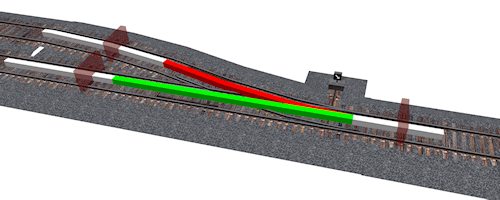Second Life Railroad/SLRR Switch
| Help Portal: |
Avatar | Bug Fixes | Communication | Community | Glossary | Land & Sim | Multimedia | Navigation | Object | Video Tutorials | Viewer | Wiki | Misc |
Description
On the following page you find a concept of how a semi automated rail switch system could help users switch track.
If you have a different idea about the concept as descripted here you can use the Talk page to add your comments, idea's and suggestions. Please don't add them in this text
Background information
On the Northern Continent there are a few sections of railway lines. Some are under construction and other are in full operation. At the moment none of the 'Branch lines' or 'Pass tracks' are connected to each other. This is because there are no switch points to go from one track (guide rail) to an other.
Having the ability to switch from one track to the other is an essential part of any rail network. This can be done in many different ways. It depends on the type of guidance used to make the train move along the tracks. But also on the type of trains that use the system.
- One way to construct a switch point is to make a fully automated system that know where trains are on the line and sets the switches accordingly. This may limit the freedom of use of the SLRR tracks.
- An other way is to construct a manual switch point. Giving the ability of user to choose what track they want to ride next. Either by e.g. a chat command or a touch to a control box. This would give griefers the ability to derail SLRR train riders.
- A third option to construct a switch is a semi automated way. But stand-alone in the network. This would give even inexperienced SLRR user the ability to ride the SLRR tracks and the more experienced users full control over where they wanted to go.
On this page we are going to show a concept of an semi automated switch.
Drawing

- Guide rail
- white normal Guide rail
- green normal Guide rail on the switch named "Guide" and unlinked
- red switched off Guide rail and renamed "OFF-Guide" and made phantom and linked
- Control box
- Detector
- A for trains going down the main line
- B for trains going down the branch line toward the main line
- Z for trains going up the main line or up the branch line
System description
The above semi automated system could be scripted to the following rules
Basics
- A Guide rail in use (direction of travel, depicted in green)
prim attributes - prim name: 'Guide' - NOT phantom - Material: Glass - Unlinked (if made up in more then 1 section) - Texture: Transparent
- A Guide rail not in use (switched off, depicted in red)
prim attributes - prim name: 'OFF-Guide' - phantom - Material: Glass - Linked (to save on open listener inside scripts) - Texture: Transparent
- Control box can be given any shape or form. It houses the main scripts that talk to the Guide rail sections as well as the train Detectors A, B and Z.
- Detectors A, B, Z have collision based scripts in them and talk to the main script in the control box.
Operational rules
- If a train arrives at (has collided with) detector A the line switches automatically to allow the train to pass from A to Z
- If a train arrives at (has collided with) detector B the line switches automatically to allow the train to pass from B to Z
- If a train arrives at (has collided with) detector Z the line does not switches automatically
- If a train has collided with detector A or B the system can not be switched over (the train is on the switch point). As soon as the train passes detector Z the system is free to change direction again.
- if a train has collided with detector A or B but did not arrive after a given time passed detector Z the system needs to be reset automatically.
- If a train has collided with detector Z the system can not be switched over (the train is on the switch point). As soon as the train passes detector A or B the system is free to change direction again.
- if a train has collided with detector Z but did not arrive after a given time passed detector A or B the system needs to be reset automatically.
- If a train is near detector Z but has not yet collided with it the user can manually switch tracks by clicking the control box.
CORRECTION: Locomotives that are phantom and/or non-physical will not trigger this system! A short-range avatar sensor would be useful in this situation to switch locomotives carrying an avatar. Public systems such as the SLRR must take all types of trains into consideration, private systems do not. Jer Straaf
Source
The above information was collected by Stryker Jenkins.
Linden Lab is currently the "operator" of the SLRR track. This is just a concept hoped to be of use to those who construct SLRR tracks.
Also See
- Second_Life_Railroad (main page)
- SLRR standards
- Wikipedia: Rail gauge
